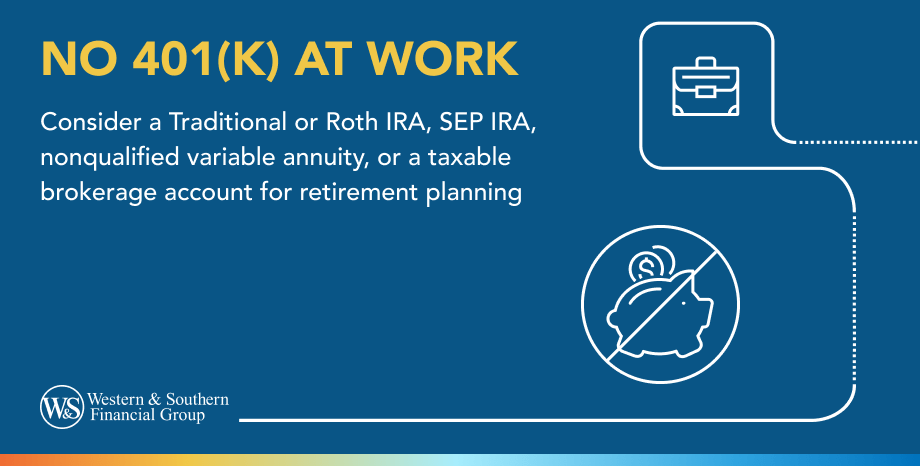Table of Contents
Table of Contents


Key Takeaways
- Traditional IRA allows pretax contributions with tax-deferred growth and taxable distributions, while Roth IRA involves after-tax contributions with tax-free qualified distributions in retirement.
- SEP IRA is suitable for self-employed individuals with zero to five employees, allowing pretax contributions up to $70,000 per year or 25% of annual income, according to the IRS.
- If you lack a 401(k) at work, explore various retirement options like IRAs, SEP IRA, nonqualified variable annuity, or taxable brokerage accounts, understanding their associated risks and aligning them with your financial objectives, risk tolerance, and time horizon.
Traditional individual retirement accounts (IRAs) offer tax-deferred savings, which makes them similar to 401(k)s. Since IRAs have certain income limitations, other options, such as variable annuities and taxable brokerage accounts, may also be worth considering.
Traditional IRA
Like a traditional 401(k), contributions are made to a traditional IRA on a pretax basis. Growth is tax-deferred and distributions are taxed as ordinary income.
Annual Maximum IRA Contributions
An additional $1,000 annual catch-up contribution may be made by those age 50 and over.
Roth IRA
Like a Roth 401(k), contributions are made to a Roth IRA on an after-tax basis. Qualified distributions in retirement are therefore tax-free provided that certain criteria are met. You must be at least age 59 1/2 and have had the account for at least five years to take qualified distributions. The maximum annual contribution to a Roth IRA is the same as a traditional IRA: $7,000 for people under 50 and $8,000 for people age 50 and over for 2025.
Please note that a person can contribute to a Roth IRA as long as you have earned an income (up to a limit set by the IRS).
SEP IRA
A Simplified Employee Pension (SEP) IRA is available for self-employed individuals with zero to five employees. Contributions are made on a pretax basis and may not exceed the lesser of $70,000 per year for 2025 or 25% of annual income, according to the IRS.
Nonqualified Variable Annuity
Contributions to a nonqualified variable annuity are made on an after-tax basis and growth is tax-deferred. The earnings are taxed as ordinary income. There is no annual maximum contribution amount and there are no income limitations to make contributions. Although nonqualified annuities are not designed to be retirement savings vehicles, they might help increase your tax-deferred growth.
Taxable Brokerage Account
Contributions are made on an after-tax basis. Account holders pay taxes annually on dividends, interest and capital gains. Employers may make matching contributions to a 401(k) plan on a pretax basis.
401(K) Maximum Annual Contributions
Distributions from a traditional 401(k) are taxed as ordinary income for the calendar year in which they are withdrawn. Qualified Roth 401(k) distributions are tax-free, as long as you are at least age 59 1/2 and have had the account for at least five years, because the account holder pays taxes on contributions. The IRS imposes a 10% early withdrawal penalty on both traditional and Roth distributions made prior to age 59 1/2.2 We recommend you speak to a tax advisor about your situation.
Bottom Line
If you don't have a 401(k) at work, you might want to contribute regularly to a retirement plan or to a long-term investment account that will suit your personal financial situation. Whether you do it yourself, or if you work with a financial representative, consider alternatives to a 401(k) that will work for you.
Investments inside IRAs, Roth IRAs, SEP IRAs, brokerage accounts, and variable annuities are subject to market and other types of risk. You have to potential to lose some or all of the principal amount invested. It is important that you consider your specific investment objectives, risk tolerance, and time horizon before investing.
Consider alternatives like personal savings accounts to reach your long-term retirement goals. Start Your Free Plan
Sources
- 401(k) limit increases to $23,500 for 2025, IRA limit remains $7,000. https://www.irs.gov/newsroom/401k-limit-increases-to-23500-for-2025-ira-limit-remains-7000.
- Retirement Topics - Exceptions to Tax on Early Distributions. https://www.irs.gov/retirement-plans/plan-participant-employee/retirement-topics-tax-on-early-distributions.


















